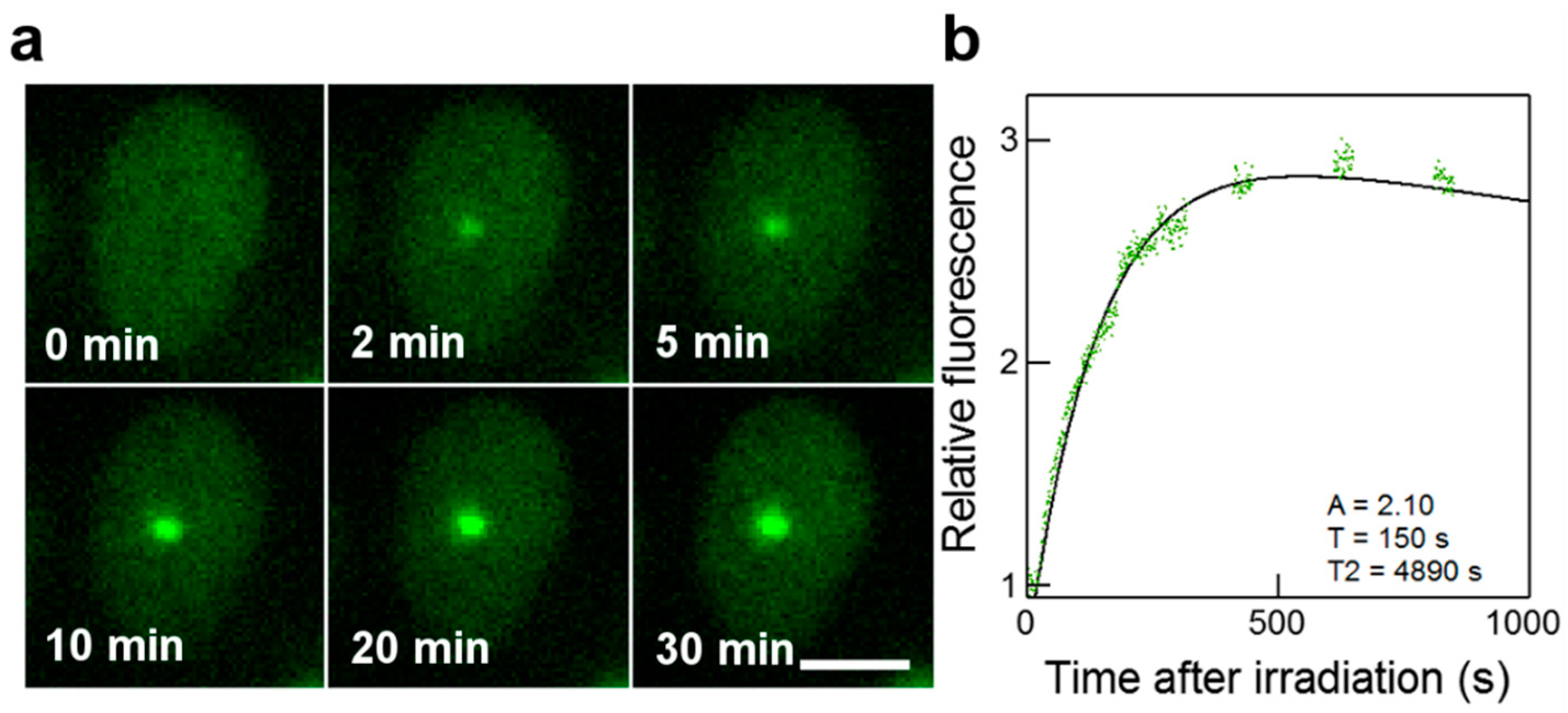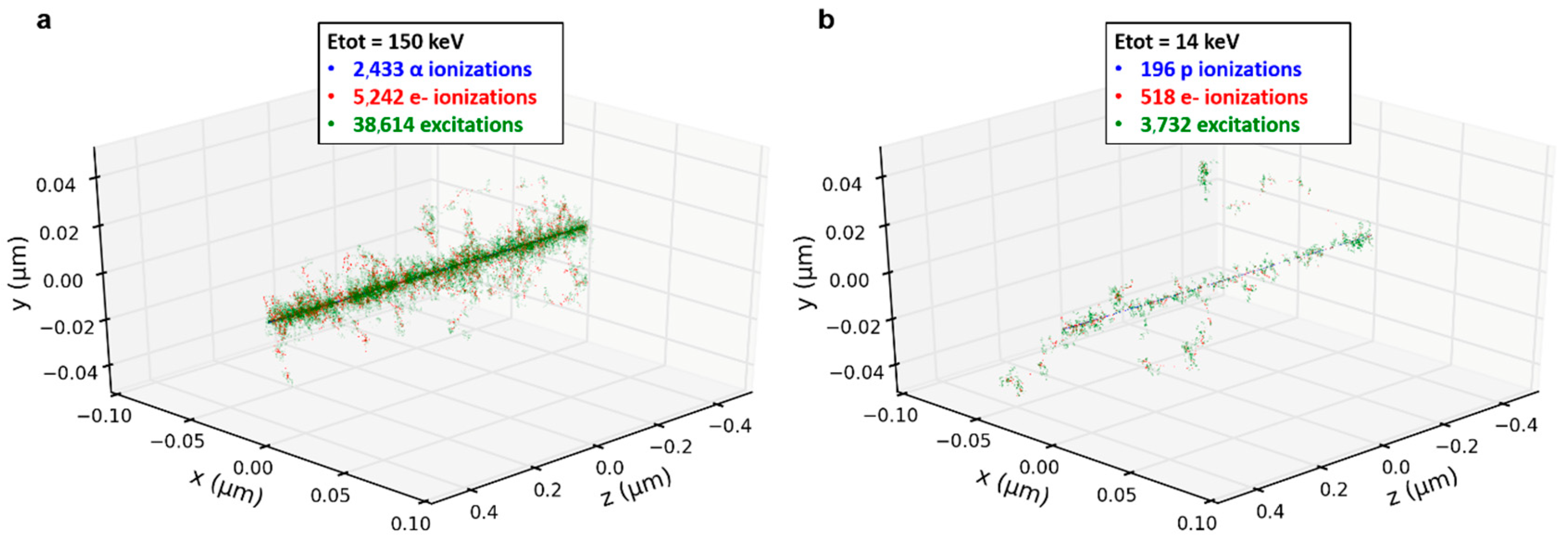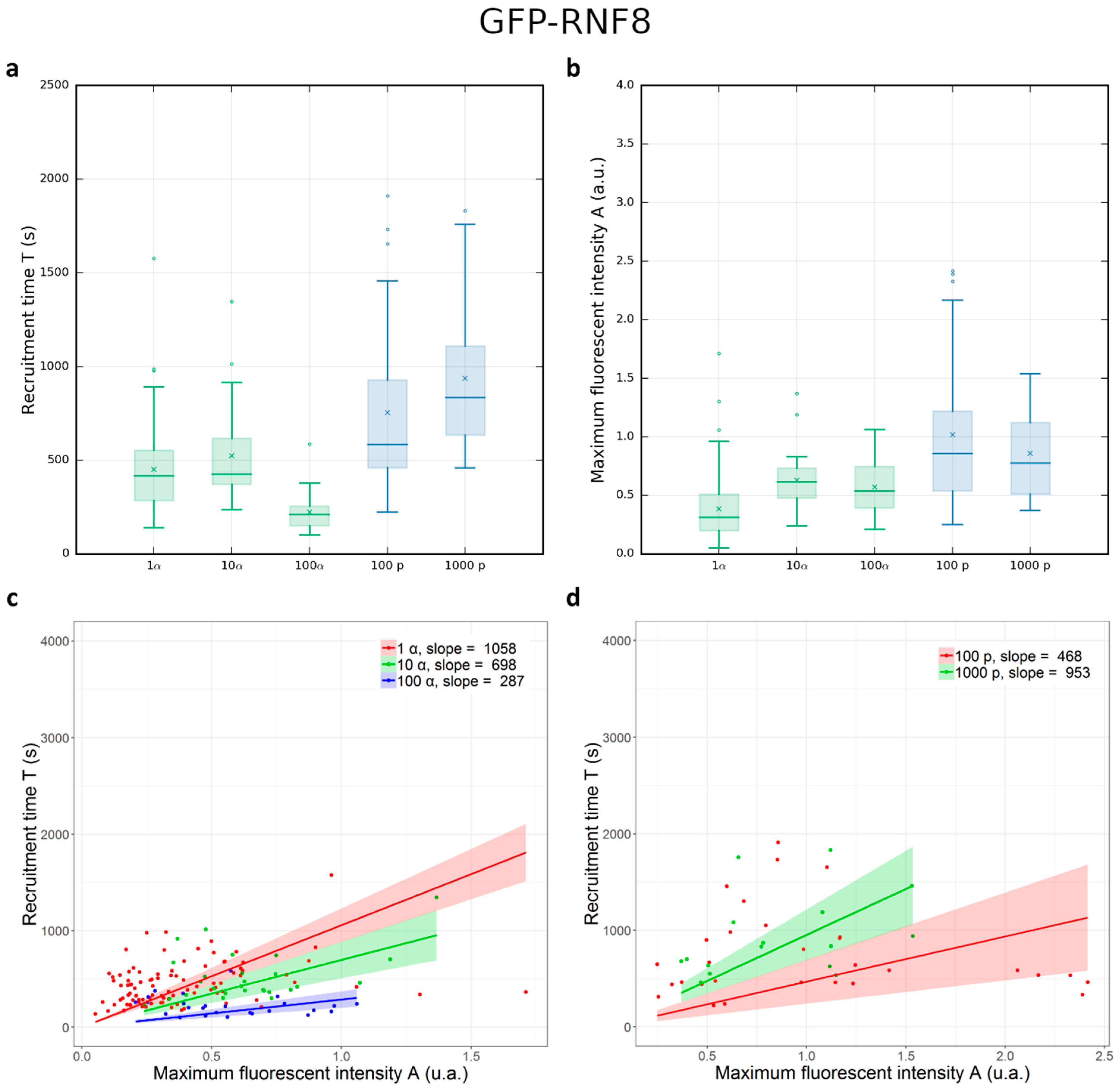Recruitment Kinetics of XRCC1 and RNF8 Following MeV Proton and α-Particle Micro-Irradiation
Abstract
Simple Summary
Abstract
1. Introduction
2. Materials and Methods
2.1. Beam Line Characteristics
2.2. Dosimetric Simulation Using the Geant4 Monte Carlo Toolkit
2.3. Cell Culture, Transfection, and Irradiation
2.4. Image Acquisition, Processing, and Fitting Models
3. Results
3.1. Energy Deposits and Track Structure of 3 MeV Protons and α-Particles
3.2. Recruitment Kinetics of GFP-Tagged XRCC1 to DNA Damage Sites after Irradiations
3.3. Recruitment Kinetics of GFP-Tagged RNF8 to DNA Damage Sites after Irradiations
4. Discussion
5. Conclusions
Supplementary Materials
Author Contributions
Funding
Institutional Review Board Statement
Informed Consent Statement
Data Availability Statement
Acknowledgments
Conflicts of Interest
References
- Maxwell, C.A.; Fleisch, M.C.; Costes, S.V.; Erickson, A.C.; Boissière, A.; Gupta, R.; Ravani, S.A.; Parvin, B.; Barcellos-Hoff, M.H. Targeted and Nontargeted Effects of Ionizing Radiation That Impact Genomic Instability. Cancer Res. 2008, 68, 8304–8311. [Google Scholar] [CrossRef] [PubMed]
- Desouky, O.; Ding, N.; Zhou, G. Targeted and Non-Targeted Effects of Ionizing Radiation. J. Radiat. Res. Appl. Sci. 2015, 8, 247–254. [Google Scholar] [CrossRef]
- Sage, E.; Shikazono, N. Radiation-Induced Clustered DNA Lesions: Repair and Mutagenesis. Free Radic. Biol. Med. 2017, 107, 125–135. [Google Scholar] [CrossRef] [PubMed]
- Hable, V.; Drexler, G.A.; Brüning, T.; Burgdorf, C.; Greubel, C.; Derer, A.; Seel, J.; Strickfaden, H.; Cremer, T.; Friedl, A.A.; et al. Recruitment Kinetics of DNA Repair Proteins Mdc1 and Rad52 but Not 53BP1 Depend on Damage Complexity. PLoS ONE 2012, 7, e41943. [Google Scholar] [CrossRef]
- Mortusewicz, O.; Leonhardt, H.; Cardoso, M.C. Spatiotemporal Dynamics of Regulatory Protein Recruitment at DNA Damage Sites. J. Cell. Biochem. 2008, 104, 1562–1569. [Google Scholar] [CrossRef]
- Gassman, N.R.; Wilson, S.H. Micro-Irradiation Tools to Visualize Base Excision Repair and Single-Strand Break Repair. DNA Repair 2015, 31, 52–63. [Google Scholar] [CrossRef]
- Solarczyk, K.J.; Kordon, M.; Berniak, K.; Dobrucki, J.W. Two Stages of XRCC1 Recruitment and Two Classes of XRCC1 Foci Formed in Response to Low Level DNA Damage Induced by Visible Light, or Stress Triggered by Heat Shock. DNA Repair 2016, 37, 12–21. [Google Scholar] [CrossRef]
- Feng, L.; Chen, J. The E3 Ligase RNF8 Regulates KU80 Removal and NHEJ Repair. Nat. Struct. Mol. Biol. 2012, 19, 201–206. [Google Scholar] [CrossRef]
- Mailand, N.; Bekker-Jensen, S.; Faustrup, H.; Melander, F.; Bartek, J.; Lukas, C.; Lukas, J. RNF8 Ubiquitylates Histones at DNA Double-Strand Breaks and Promotes Assembly of Repair Proteins. Cell 2007, 131, 887–900. [Google Scholar] [CrossRef]
- Drexler, G.A.; Ruiz-Gomez, M.J. Microirradiation Techniques in Radiobiological Research. J. Biosci. 2015, 40, 629–643. [Google Scholar] [CrossRef]
- Tobias, F.; Durante, M.; Taucher-Scholz, G.; Jakob, B. Spatiotemporal Analysis of DNA Repair Using Charged Particle Radiation. Mutat. Res. /Rev. Mutat. Res. 2010, 704, 54–60. [Google Scholar] [CrossRef] [PubMed]
- Mosconi, M.; Giesen, U.; Langner, F.; Mielke, C.; Dalla Rosa, I.; Dirks, W.G. 53BP1 and MDC1 Foci Formation in HT-1080 Cells for Low- and High-LET Microbeam Irradiations. Radiat. Environ. Biophys. 2011, 50, 345–352. [Google Scholar] [CrossRef] [PubMed]
- Guo, N.; Du, G.; Liu, W.; Guo, J.; Wu, R.; Chen, H.; Wei, J. Live Cell Imaging Combined with High-Energy Single-Ion Microbeam. Rev. Sci. Instrum. 2016, 87, 034301. [Google Scholar] [CrossRef] [PubMed]
- Schettino, G.; Ghita, M.; Richard, D.J.; Prise, K.M. Spatiotemporal Investigations of DNA Damage Repair Using Microbeams. Radiat. Prot. Dosim. 2011, 143, 340–343. [Google Scholar] [CrossRef]
- Muggiolu, G.; Pomorski, M.; Claverie, G.; Berthet, G.; Mer-Calfati, C.; Saada, S.; Deves, G.; Simon, M.; Seznec, H.; Barberet, P. Single Alpha-Particle Irradiation Permits Real-Time Visualization of RNF8 Accumulation at DNA Damaged Sites. Sci. Rep. 2017, 7, 41764. [Google Scholar] [CrossRef]
- Reynolds, P.; Botchway, S.W.; Parker, A.W.; O’Neill, P. Spatiotemporal Dynamics of DNA Repair Proteins Following Laser Microbeam Induced DNA Damage – When Is a DSB Not a DSB? Mutat. Res./Genet. Toxicol. Environ. Mutagen. 2013, 756, 14–20. [Google Scholar] [CrossRef]
- Tobias, F.; Loeb, D.; Lengert, N.; Durante, M.; Drossel, B.; Taucher-Scholz, G.; Jakob, B. Spatiotemporal Dynamics of Early DNA Damage Response Proteins on Complex DNA Lesions. PLoS ONE 2013, 8, e57953. [Google Scholar] [CrossRef]
- Vadhavkar, N.; Pham, C.; Georgescu, W.; Deschamps, T.; Heuskin, A.-C.; Tang, J.; Costes, S.V. Combinatorial DNA Damage Pairing Model Based on X-Ray-Induced Foci Predicts the Dose and LET Dependence of Cell Death in Human Breast Cells. Rare 2014, 182, 273–281. [Google Scholar] [CrossRef]
- Agostinelli, S.; Allison, J.; Amako, K.; Apostolakis, J.; Araujo, H.; Arce, P.; Asai, M.; Axen, D.; Banerjee, S.; Barrand, G.; et al. Geant4—A Simulation Toolkit. Nucl. Instrum. Methods Phys. Res. Sect. A Accel. Spectrometers Detect. Assoc. Equip. 2003, 506, 250–303. [Google Scholar] [CrossRef]
- Bernal, M.A.; Bordage, M.C.; Brown, J.M.C.; Davídková, M.; Delage, E.; Bitar, Z.E.; Enger, S.A.; Francis, Z.; Guatelli, S.; Ivanchenko, V.N.; et al. Track Structure Modeling in Liquid Water: A Review of the Geant4-DNA Very Low Energy Extension of the Geant4 Monte Carlo Simulation Toolkit. Phys. Med. Eur. J. Med. Phys. 2015, 31, 861–874. [Google Scholar] [CrossRef]
- Barberet, P.; Jouve, J.; Sorieul, S.; Alfaurt, P.; Mathieu, L. AIFIRA: A Light Ion Beam Facility for Ion Beam Analysis and Irradiation. Eur. Phys. J. Plus 2021, 136, 67. [Google Scholar] [CrossRef]
- Bourret, S.; Vianna, F.; Deves, G.; Atallah, V.; Moretto, P.; Seznec, H.; Barberet, P. Fluorescence Time-Lapse Imaging of Single Cells Targeted with a Focused Scanning Charged-Particle Microbeam. Nucl. Instrum. Methods Phys. Res. Sect. B-Beam Interact. Mater. At. 2014, 325, 27–34. [Google Scholar] [CrossRef]
- Hanssen-Bauer, A.; Solvang-Garten, K.; Akbari, M.; Otterlei, M. X-Ray Repair Cross Complementing Protein 1 in Base Excision Repair. Int. J. Mol. Sci. 2012, 13, 17210–17229. [Google Scholar] [CrossRef] [PubMed]
- Caldecott, K.W. XRCC1 Protein; Form and Function. DNA Repair (Amst.) 2019, 81, 102664. [Google Scholar] [CrossRef] [PubMed]
- Campalans, A.; Kortulewski, T.; Amouroux, R.; Menoni, H.; Vermeulen, W.; Radicella, J.P. Distinct Spatiotemporal Patterns and PARP Dependence of XRCC1 Recruitment to Single-Strand Break and Base Excision Repair. Nucleic Acids Res. 2013, 41, 3115–3129. [Google Scholar] [CrossRef] [PubMed]
- Wei, L.; Nakajima, S.; Hsieh, C.-L.; Kanno, S.; Masutani, M.; Levine, A.S.; Yasui, A.; Lan, L. Damage Response of XRCC1 at Sites of DNA Single Strand Breaks Is Regulated by Phosphorylation and Ubiquitylation after Degradation of Poly(ADP-Ribose). J. Cell Sci. 2013, 126, 4414–4423. [Google Scholar] [CrossRef]
- Sallmyr, A.; Tomkinson, A.E. Repair of DNA Double-Strand Breaks by Mammalian Alternative End-Joining Pathways. J. Biol. Chem. 2018, 293, 10536–10546. [Google Scholar] [CrossRef]
- Dueva, R.; Iliakis, G. Alternative Pathways of Non-Homologous End Joining (NHEJ) in Genomic Instability and Cancer. Transl. Cancer Res. 2013, 2. [Google Scholar] [CrossRef]
- Frit, P.; Barboule, N.; Yuan, Y.; Gomez, D.; Calsou, P. Alternative End-Joining Pathway(s): Bricolage at DNA Breaks. DNA Repair 2014, 17, 81–97. [Google Scholar] [CrossRef]
- Boboila, C.; Oksenych, V.; Gostissa, M.; Wang, J.H.; Zha, S.; Zhang, Y.; Chai, H.; Lee, C.-S.; Jankovic, M.; Saez, L.-M.A.; et al. Robust Chromosomal DNA Repair via Alternative End-Joining in the Absence of X-Ray Repair Cross-Complementing Protein 1 (XRCC1). Proc. Natl. Acad. Sci. USA 2012, 109, 2473–2478. [Google Scholar] [CrossRef]
- Yan, J.; Jetten, A.M. RAP80 and RNF8, Key Players in the Recruitment of Repair Proteins to DNA Damage Sites. Cancer Lett. 2008, 271, 179–190. [Google Scholar] [CrossRef] [PubMed]
- Thorslund, T.; Ripplinger, A.; Hoffmann, S.; Wild, T.; Uckelmann, M.; Villumsen, B.; Narita, T.; Sixma, T.K.; Choudhary, C.; Bekker-Jensen, S.; et al. Histone H1 Couples Initiation and Amplification of Ubiquitin Signalling after DNA Damage. Nature 2015, 527, 389–393. [Google Scholar] [CrossRef] [PubMed]
- Doil, C.; Mailand, N.; Bekker-Jensen, S.; Menard, P.; Larsen, D.H.; Pepperkok, R.; Ellenberg, J.; Panier, S.; Durocher, D.; Bartek, J.; et al. RNF168 Binds and Amplifies Ubiquitin Conjugates on Damaged Chromosomes to Allow Accumulation of Repair Proteins. Cell 2009, 136, 435–446. [Google Scholar] [CrossRef] [PubMed]
- Chen, B.-R.; Sleckman, B.P. The Regulation of DNA End Resection by Chromatin Response to DNA Double Strand Breaks. Front. Cell Dev. Biol. 2022, 10, 932633. [Google Scholar] [CrossRef] [PubMed]
- Kolobynina, K.G.; Rapp, A.; Cardoso, M.C. Chromatin Ubiquitination Guides DNA Double Strand Break Signaling and Repair. Front. Cell Dev. Biol. 2022, 10, 928113. [Google Scholar] [CrossRef]
- Mortusewicz, O.; Leonhardt, H. XRCC1 and PCNA Are Loading Platforms with Distinct Kinetic Properties and Different Capacities to Respond to Multiple DNA Lesions. BMC Mol. Biol. 2007, 8, 81. [Google Scholar] [CrossRef]
- Menoni, H.; Wienholz, F.; Theil, A.F.; Janssens, R.C.; Lans, H.; Campalans, A.; Radicella, J.P.; Marteijn, J.A.; Vermeulen, W. The Transcription-Coupled DNA Repair-Initiating Protein CSB Promotes XRCC1 Recruitment to Oxidative DNA Damage. Nucleic Acids Res. 2018, 46, 7747–7756. [Google Scholar] [CrossRef]
- Mok, M.C.Y.; Campalans, A.; Pillon, M.C.; Guarné, A.; Radicella, J.P.; Junop, M.S. Identification of an XRCC1 DNA Binding Activity Essential for Retention at Sites of DNA Damage. Sci. Rep. 2019, 9, 3095. [Google Scholar] [CrossRef]
- Zhao, M.-L.; Stefanick, D.F.; Nadalutti, C.A.; Beard, W.A.; Wilson, S.H.; Horton, J.K. Temporal Recruitment of Base Excision DNA Repair Factors in Living Cells in Response to Different Micro-Irradiation DNA Damage Protocols. DNA Repair 2023, 126, 103486. [Google Scholar] [CrossRef]
- Luijsterburg, M.S.; Acs, K.; Ackermann, L.; Wiegant, W.W.; Bekker-Jensen, S.; Larsen, D.H.; Khanna, K.K.; van Attikum, H.; Mailand, N.; Dantuma, N.P. A New Non-Catalytic Role for Ubiquitin Ligase RNF8 in Unfolding Higher-Order Chromatin Structure. EMBO J. 2012, 31, 2511–2527. [Google Scholar] [CrossRef]
- Luijsterburg, M.S.; van Attikum, H. Close Encounters of the RNF8th Kind: When Chromatin Meets DNA Repair. Curr. Opin. Cell Biol. 2012, 24, 439–447. [Google Scholar] [CrossRef] [PubMed]
- Kochan, J.A.; van den Belt, M.; von der Lippe, J.; Desclos, E.C.B.; Steurer, B.; Hoebe, R.A.; Scutigliani, E.M.; Verhoeven, J.; Stap, J.; Bosch, R.; et al. Ultra-Soft X-Ray System for Imaging the Early Cellular Responses to X-Ray Induced DNA Damage. Nucleic Acids Res. 2019, 47, e100. [Google Scholar] [CrossRef] [PubMed]
- Tan, Q.; Niu, K.; Zhu, Y.; Chen, Z.; Li, Y.; Li, M.; Wei, D.; Balajee, A.S.; Fang, H.; Zhao, Y. RNF8 Ubiquitinates RecQL4 and Promotes Its Dissociation from DNA Double Strand Breaks. Oncogenesis 2021, 10, 24. [Google Scholar] [CrossRef]
- Edelstein, A.D.; Tsuchida, M.A.; Amodaj, N.; Pinkard, H.; Vale, R.D.; Stuurman, N. Advanced Methods of Microscope Control Using ΜManager Software. J. Biol. Methods 2014, 1, e10. [Google Scholar] [CrossRef] [PubMed]
- Incerti, S.; Ivanchenko, A.; Karamitros, M.; Mantero, A.; Moretto, P.; Tran, H.N.; Mascialino, B.; Champion, C.; Ivanchenko, V.N.; Bernal, M.A.; et al. Comparison of GEANT4 Very Low Energy Cross Section Models with Experimental Data in Water. Med. Phys. 2010, 37, 4692–4708. [Google Scholar] [CrossRef] [PubMed]
- Lan, L.; Nakajima, S.; Oohata, Y.; Takao, M.; Okano, S.; Masutani, M.; Wilson, S.H.; Yasui, A. In Situ Analysis of Repair Processes for Oxidative DNA Damage in Mammalian Cells. Proc. Natl. Acad. Sci. USA 2004, 101, 13738–13743. [Google Scholar] [CrossRef]
- Lukas, C.; Melander, F.; Stucki, M.; Falck, J.; Bekker-Jensen, S.; Goldberg, M.; Lerenthal, Y.; Jackson, S.P.; Bartek, J.; Lukas, J. Mdc1 Couples DNA Double-Strand Break Recognition by Nbs1 with Its H2AX-Dependent Chromatin Retention. EMBO J. 2004, 23, 2674–2683. [Google Scholar] [CrossRef]
- Barberet, P.; Vianna, F.; Karamitros, M.; Brun, T.; Gordillo, N.; Moretto, P.; Incerti, S.; Seznec, H. Monte-Carlo Dosimetry on a Realistic Cell Monolayer Geometry Exposed to Alpha Particles. Phys. Med. Biol. 2012, 57, 2189–2207. [Google Scholar] [CrossRef]
- Barberet, P.; Pomorski, M.; Muggiolu, G.; Torfeh, E.; Claverie, G.; Huss, C.; Saada, S.; Deves, G.; Simon, M.; Seznec, H. Cell Micro-Irradiation with MeV Protons Counted by an Ultra-Thin Diamond Membrane. Appl. Phys. Lett. 2017, 111, 243701. [Google Scholar] [CrossRef]
- Ghita, M.; Fernandez-Palomo, C.; Fukunaga, H.; Fredericia, P.M.; Schettino, G.; Bräuer-Krisch, E.; Butterworth, K.T.; McMahon, S.J.; Prise, K.M. Microbeam Evolution: From Single Cell Irradiation to Pre-Clinical Studies. Int. J. Radiat. Biol. 2018, 94, 708–718. [Google Scholar] [CrossRef]
- Zentout, S.; Smith, R.; Jacquier, M.; Huet, S. New Methodologies to Study DNA Repair Processes in Space and Time Within Living Cells. Front. Cell Dev. Biol. 2021, 9, 730998. [Google Scholar] [CrossRef] [PubMed]
- van Veelen, L.R.; Cervelli, T.; van de Rakt, M.W.M.M.; Theil, A.F.; Essers, J.; Kanaar, R. Analysis of Ionizing Radiation-Induced Foci of DNA Damage Repair Proteins. Mutat. Res./Fundam. Mol. Mech. Mutagen. 2005, 574, 22–33. [Google Scholar] [CrossRef] [PubMed]
- Jakob, B.; Splinter, J.; Durante, M.; Taucher-Scholz, G. Live Cell Microscopy Analysis of Radiation-Induced DNA Double-Strand Break Motion. Proc. Natl. Acad. Sci. USA 2009, 106, 3172–3177. [Google Scholar] [CrossRef]
- Costes, S.V.; Chiolo, I.; Pluth, J.M.; Barcellos-Hoff, M.H.; Jakob, B. Spatiotemporal Characterization of Ionizing Radiation Induced DNA Damage Foci and Their Relation to Chromatin Organization. Mutat. Res. 2010, 704, 78–87. [Google Scholar] [CrossRef]
- Hanton, F.; Chaudhary, P.; Doria, D.; Gwynne, D.; Maiorino, C.; Scullion, C.; Ahmed, H.; Marshall, T.; Naughton, K.; Romagnani, L.; et al. DNA DSB Repair Dynamics Following Irradiation with Laser-Driven Protons at Ultra-High Dose Rates. Sci. Rep. 2019, 9, 4471. [Google Scholar] [CrossRef] [PubMed]
- Lorat, Y.; Reindl, J.; Isermann, A.; Rübe, C.; Friedl, A.A.; Rübe, C.E. Focused Ion Microbeam Irradiation Induces Clustering of DNA Double-Strand Breaks in Heterochromatin Visualized by Nanoscale-Resolution Electron Microscopy. Int. J. Mol. Sci. 2021, 22, 7638. [Google Scholar] [CrossRef] [PubMed]
- Nakajima, N.I.; Brunton, H.; Watanabe, R.; Shrikhande, A.; Hirayama, R.; Matsufuji, N.; Fujimori, A.; Murakami, T.; Okayasu, R.; Jeggo, P.; et al. Visualisation of ΓH2AX Foci Caused by Heavy Ion Particle Traversal; Distinction between Core Track versus Non-Track Damage. PLoS ONE 2013, 8, e70107. [Google Scholar] [CrossRef]
- Wu, J.; Hei, T.K. Focus Small to Find Big–the Microbeam Story. Int. J. Radiat. Biol. 2018, 94, 782–788. [Google Scholar] [CrossRef]
- Jakob, B.; Splinter, J.; Conrad, S.; Voss, K.-O.; Zink, D.; Durante, M.; Löbrich, M.; Taucher-Scholz, G. DNA Double-Strand Breaks in Heterochromatin Elicit Fast Repair Protein Recruitment, Histone H2AX Phosphorylation and Relocation to Euchromatin. Nucleic Acids Res. 2011, 39, 6489–6499. [Google Scholar] [CrossRef]
- Asaithamby, A.; Chen, D.J. Mechanism of Cluster DNA Damage Repair in Response to High-Atomic Number and Energy Particles Radiation. Mutat. Res./Fundam. Mol. Mech. Mutagen. 2011, 711, 87–99. [Google Scholar] [CrossRef]
- Liu, W.; Wu, R.; Guo, J.; Shen, C.; Zhao, J.; Mao, G.; Mou, H.; Zhang, L.; Du, G. High Turnover and Rescue Effect of XRCC1 in Response to Heavy Charged Particle Radiation. Biophys. J. 2022, 121, 1493–1501. [Google Scholar] [CrossRef] [PubMed]
- Sakata, D.; Lampe, N.; Karamitros, M.; Kyriakou, I.; Belov, O.; Bernal, M.A.; Bolst, D.; Bordage, M.-C.; Breton, V.; Brown, J.M.C.; et al. Evaluation of Early Radiation DNA Damage in a Fractal Cell Nucleus Model Using Geant4-DNA. Phys. Med. Eur. J. Med. Phys. 2019, 62, 152–157. [Google Scholar] [CrossRef]
- Kolas, N.K.; Chapman, J.R.; Nakada, S.; Ylanko, J.; Chahwan, R.; Sweeney, F.D.; Panier, S.; Mendez, M.; Wildenhain, J.; Thomson, T.M.; et al. Orchestration of the DNA-Damage Response by the RNF8 Ubiquitin Ligase. Science 2007, 318, 1637–1640. [Google Scholar] [CrossRef] [PubMed]
- Huen, M.S.Y.; Grant, R.; Manke, I.; Minn, K.; Yu, X.; Yaffe, M.B.; Chen, J. The E3 Ubiquitin Ligase RNF8 Transduces the DNA Damage Signal via an Ubiquitin-Dependent Signaling Pathway. Cell 2007, 131, 901–914. [Google Scholar] [CrossRef] [PubMed]
- Bartocci, C.; Denchi, E.L. Put a RING on It: Regulation and Inhibition of RNF8 and RNF168 RING Finger E3 Ligases at DNA Damage Sites. Front. Genet. 2013, 4, 128. [Google Scholar] [CrossRef] [PubMed]
- Mok, M.T.S.; Cheng, A.S.L.; Henderson, B.R. The Ubiquitin Ligases RNF8 and RNF168 Display Rapid but Distinct Dynamics at DNA Repair Foci in Living Cells. Int. J. Biochem. Cell Biol. 2014, 57, 27–34. [Google Scholar] [CrossRef] [PubMed]
- Lu, C.-S.; Truong, L.N.; Aslanian, A.; Shi, L.Z.; Li, Y.; Hwang, P.Y.-H.; Koh, K.H.; Hunter, T.; Yates, J.R.; Berns, M.W.; et al. The RING Finger Protein RNF8 Ubiquitinates Nbs1 to Promote DNA Double-Strand Break Repair by Homologous Recombination. J. Biol. Chem. 2012, 287, 43984–43994. [Google Scholar] [CrossRef]
- Yamamoto, T.; Taira Nihira, N.; Yogosawa, S.; Aoki, K.; Takeda, H.; Sawasaki, T.; Yoshida, K. Interaction between RNF8 and DYRK2 Is Required for the Recruitment of DNA Repair Molecules to DNA Double-Strand Breaks. FEBS Lett. 2017, 591, 842–853. [Google Scholar] [CrossRef]
- Hodge, C.D.; Ismail, I.H.; Edwards, R.A.; Hura, G.L.; Xiao, A.T.; Tainer, J.A.; Hendzel, M.J.; Glover, J.N.M. RNF8 E3 Ubiquitin Ligase Stimulates Ubc13 E2 Conjugating Activity That Is Essential for DNA Double Strand Break Signaling and BRCA1 Tumor Suppressor Recruitment. J. Biol. Chem. 2016, 291, 9396–9410. [Google Scholar] [CrossRef]
- Brown, J.S.; Lukashchuk, N.; Sczaniecka-Clift, M.; Britton, S.; le Sage, C.; Calsou, P.; Beli, P.; Galanty, Y.; Jackson, S.P. Neddylation Promotes Ubiquitylation and Release of Ku from DNA-Damage Sites. Cell Rep. 2015, 11, 704–714. [Google Scholar] [CrossRef]







Disclaimer/Publisher’s Note: The statements, opinions and data contained in all publications are solely those of the individual author(s) and contributor(s) and not of MDPI and/or the editor(s). MDPI and/or the editor(s) disclaim responsibility for any injury to people or property resulting from any ideas, methods, instructions or products referred to in the content. |
© 2023 by the authors. Licensee MDPI, Basel, Switzerland. This article is an open access article distributed under the terms and conditions of the Creative Commons Attribution (CC BY) license (https://creativecommons.org/licenses/by/4.0/).
Share and Cite
Muggiolu, G.; Torfeh, E.; Simon, M.; Devès, G.; Seznec, H.; Barberet, P. Recruitment Kinetics of XRCC1 and RNF8 Following MeV Proton and α-Particle Micro-Irradiation. Biology 2023, 12, 921. https://doi.org/10.3390/biology12070921
Muggiolu G, Torfeh E, Simon M, Devès G, Seznec H, Barberet P. Recruitment Kinetics of XRCC1 and RNF8 Following MeV Proton and α-Particle Micro-Irradiation. Biology. 2023; 12(7):921. https://doi.org/10.3390/biology12070921
Chicago/Turabian StyleMuggiolu, Giovanna, Eva Torfeh, Marina Simon, Guillaume Devès, Hervé Seznec, and Philippe Barberet. 2023. "Recruitment Kinetics of XRCC1 and RNF8 Following MeV Proton and α-Particle Micro-Irradiation" Biology 12, no. 7: 921. https://doi.org/10.3390/biology12070921
APA StyleMuggiolu, G., Torfeh, E., Simon, M., Devès, G., Seznec, H., & Barberet, P. (2023). Recruitment Kinetics of XRCC1 and RNF8 Following MeV Proton and α-Particle Micro-Irradiation. Biology, 12(7), 921. https://doi.org/10.3390/biology12070921





